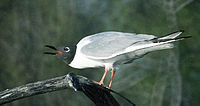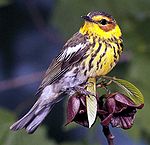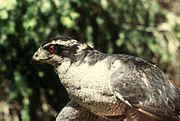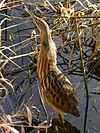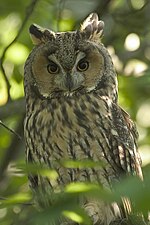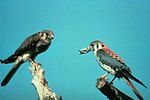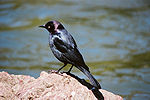This article needs additional citations for verification .(April 2024) |
The boreal forest or taiga of the North American continent stretches through a majority of Canada and most of central Alaska, extending spottily into the beginning of the Rocky Mountain range in Northern Montana and into New England and the Adirondack Mountains of New York. This habitat extends as far north as the tree line (replaced by the High Arctic tundra) and discontinues in mixed deciduous-coniferous forests to the south. The "taiga", as it is called there, of Eurasia occupies a similar range on those continents. Throughout the Northern Hemisphere, the boreal forest covers 2.3 million square miles, a larger area than the remaining Brazilian Amazon rainforest. Although it is largely forest, the boreal forests include a network of lakes, river valleys, wetlands, peat lands and semi-open tundra.
Contents
- Birds almost totally dependent on the boreal forests
- Birds that are very dependent on the boreal forests
- Birds that are partially dependent on the boreal forests
- Birds that are minimally dependent on boreal forests
- See also
- External links
- References
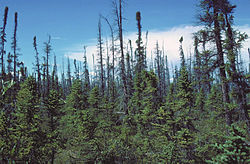
Only 8% of the Canadian boreal forest is protected and over 30% has already been designated for logging, energy and other development, much of it within the last decade. The U.S. is the leading importer of Canadian wood products as well as oil and gas, having purchased 20 billion dollars (approximately 80% of Canada's timber exports) worth of Canadian forest products in 2001. Presently trees being logged in the Boreal are primarily pulped and turned into disposable products such as toilet tissue, junk mail, and catalogs. Decisions will be made in the next several years regarding the remaining lands and where development will take place.
Historically, this wilderness has long remained vast and little-known to birding and naturalist groups, who have placed their attentions southwards. Although, the wintering grounds of many North American migratory birds also requires attention, now it has become apparent that our attention must be focused north on the Boreal breeding grounds of many of these birds. It is estimated that about 60% of the American bird population found North of the Mexican border nests in the boreal forest. About half of North America's breeding species (over 300) make their home there. The following is a list of the North American birds reliant on the boreal forests.


